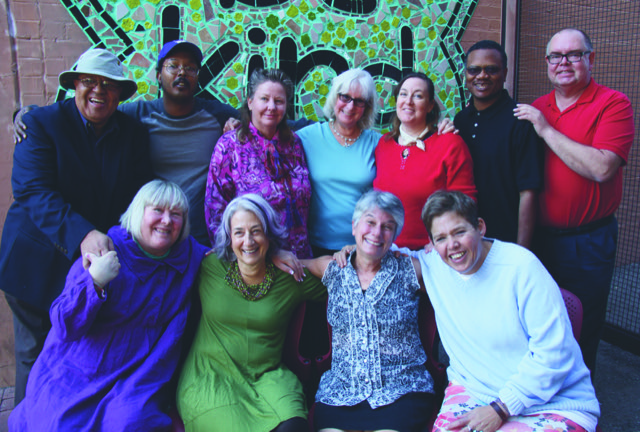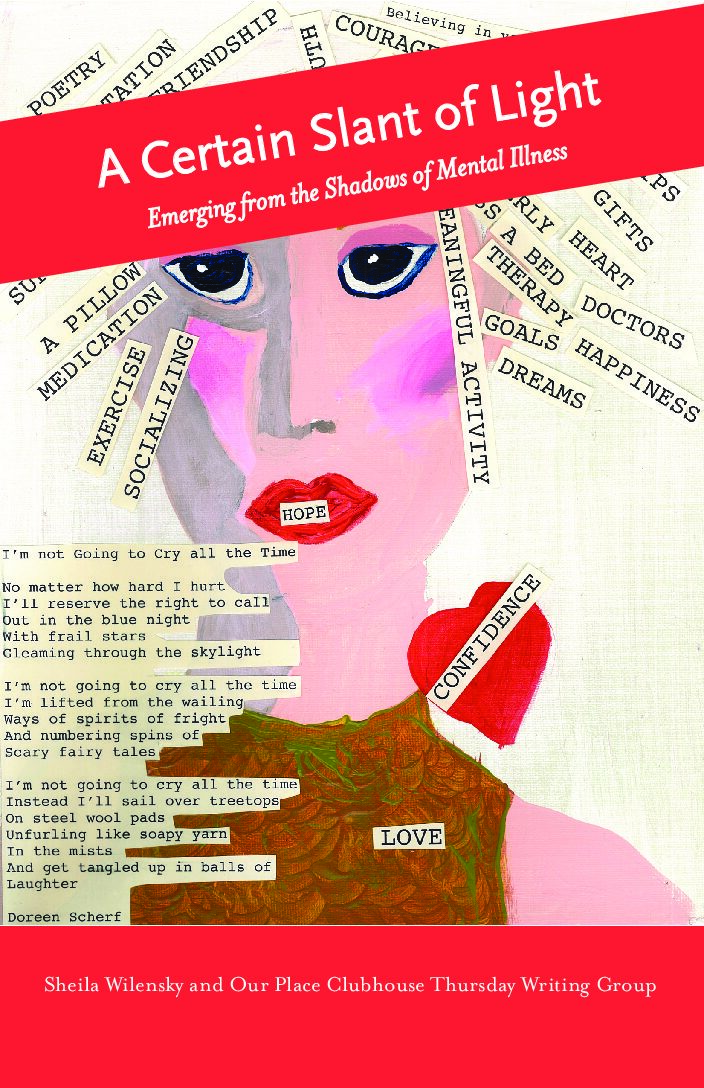Ruth threw up her hands in exasperation. “Why do people think if you have a mental illness you may pull out a gun and start shooting anytime?” she said. It was a few weeks after the January 8, 2011 mass shooting in Tucson, Arizona, that critically wounded 13 people, including U.S. Representative Gabby Giffords, and took the lives of six others. The two of us were talking prior to the weekly writing group I facilitated at Tucson’s Our Place Clubhouse, which serves as an outpatient community for individuals in recovery from serious mental illness, offering job training, cooking opportunities and meals, and a place to gather socially for individuals recommended by a healthcare professional.
Ruth is an articulate, intelligent woman who happens to have schizo-affective disorder. I empathized with her. According to the National Institute of Health, “people with mental illness are more likely to be the victims of violent crime rather than the perpetrators. This bias extends all the way to the criminal justice system, where persons with mental illness get treated as criminals, arrested, charged, and jailed for a longer time compared to the general population” (March 30, 2023, ncbi.nlm.nih.gov).
I had started Thursday Writing Group, which Ruth attended weekly, with the objective of transforming the widely held view that people with mental illness are dangerous and scary, especially those who are receiving treatment.
What more could we do, I wondered, to help reduce the stigma of mental illness in our society?
“We’re going to publish a chapbook that focuses on what it’s like to live with mental illness,” I announced to the writing group one Thursday afternoon.
Ruth’s question about gun violence gnawed at me for nearly a year before I had an epiphany. It was up to us to start educating family, friends, and the public about the ongoing stigma attached to mental illness. “We’re going to publish a chapbook that focuses on what it’s like to live with mental illness,” I announced to the writing group one Thursday afternoon. Sitting around a wooden seminar table, the group members stared at me. I don’t think they believed we could do it.
After my suggestion sank in, the energy in the room was palpable. The group included individuals of various ages and backgrounds who were contending with bipolar disorder, clinical depression, personality disorders, schizophrenia, schizo-affective disorder, and myriad other physical-emotional challenges. We yearned to help reduce the shame and secrecy connected to mental illness, to make it less scary for others to seek treatment. Writing our truths, we decided, was the path forward.
And these group members were the most truthful writers I have ever worked with. What a relief it was for them to be able to share their innermost feelings with peers who understood their life experiences. During the three years it took to put the chapbook together, we were fortunate to have a core group of committed writers who returned each week. Along the way, I wrote and read with them, exploring my own struggles with generalized anxiety disorder and those of family members living with mental illness.
These group members were the most truthful writers I have ever worked with. What a relief it was for them to be able to share their innermost feelings with peers who understood their life experiences.
One of my favorite responses to a prompt while we were working on the book was written by Ruth. She had been a student at Occidental College in California, the same college that former President Barack Obama first attended. He became President of the United States. She developed schizo-affective disorder. Ruth could have been a professor, which is what I often called her. Her life was interrupted by mental illness more than 20 years ago. Writing her truths and imaginings has been essential to her progress.
A Normal Day
I am at an impasse when it comes to what to wear. While waiting at J2 Laboratories for a blood draw one day two well-dressed men came in surrounded by an aura of achievement. I was wearing a t-shirt and really cheap cologne. Mortified, I walked around downtown feeling out of place. I’m 43 and I hope I’m more than my clothes.
––Ruth
Weekly Writing Group Activities
We started each weekly session of our Thursday Writing Group by going around the room to check in, with all participants briefly stating how their week had gone.
Together, we came up with a list of writing prompts to show future chapbook readers that the writers in this group brushed their teeth, got dressed, ate breakfast, and often went to work, just as other people did.
When writing, we used the tactics Natalie Goldberg describes in her books Writing Down the Bones and Wild Mind. Goldberg advises writers to keep their pens moving and to refrain from editing as they are writing in order to allow their inner feelings to emerge on the page.
Once we had amassed enough pages, we worked collaboratively to organize our writing into chapters that showed the flow we wanted to portray and then workshopped the pages in teams. I served as editor-in-chief and publisher, writing a brief introduction to each chapter. During this process, I engaged in minimal editing of the prompt writing, allowing the writing group members the space to contribute their insightful reflections.
As in any teaching/learning situation, creating a feeling of community was key to our success.
Together, Thursday Writing Group members eventually came up with a title for our chapbook: A Certain Slant of Light: Emerging from the Shadows of Mental Illness. As in any teaching/learning situation, creating a feeling of community was key to our success.
More than 200 people attended our book launch. Our Place Clubhouse bakers-in-training made a variety of delicious treats and set up the reception tables. The evening was a tremendous success.
Years later, I maintain a friendship with Ruth and with another staunch writing group member, Diane, a former middle school teacher. The three of us meet for lunch annually when I’m in Tucson visiting, as we did in February 2024. While we were together, I asked Diane and Ruth to talk about the impact that writing and publishing A Certain Slant of Light had on their lives.
“I learned that having a mental illness wasn’t a death sentence.” Ruth responded. “I learned that when you are working on something physically [like the chapbook], you’re working on it subconsciously, too. It was an accomplishment.” Ruth said her vocational counselor recently told her, “You have thrived.” Whether or not her ability to secure a job or attain other social successes stemmed from our chapbook writing, Ruth says the experience was a milestone for her. “I’m so much better now,” she said at this year’s lunch, handing me a stone heart as a gift.
For Diane, the biggest impact of the experience was working in community. “It put everybody on an even keel,” she said. “We supported each other. I’ve been reading through [our] beautiful book and smiling. I just love how the writers broke the silence of suffering caused by prejudice toward and misinformation about those of us with mental illness. Writing truth speaks volumes. The voices [in this book] are resounding, and I was so blessed to be a part of this process and the product.”
Currently, Diane is putting together a chapbook of her poetry and artwork, an accomplishment that stems from our work together. Ruth’s and Diane’s responses remind me how much we all need collaboration and support from others who care about us. The making of A Certain Slant of Light shows what is possible when we find it.
May our writing continue!

Key Steps in Creating Our Chapbook
- Selecting weekly writing prompts, such as “Any Morning,” “Family Stories,” “Ups and Downs,” “Nurturing Ourselves,” “Acceptance,” and “Take Heart.”
- Using Natalie Goldberg’s writing tactics, which include writing for a certain period of time and then reading aloud to the group—or choosing to pass. When someone is reading, other group members simply listen. This isn’t a time for feedback.
- Agreeing on the prompt writing to be included in the chapbook. As editor-in-chief, I had the final say on the inclusion and order of the topics.
- Engaging a graphic artist friend to design the chapbook.
- Coming up with my introduction and a preface by one of the surviving victims of the January 8th mass shooting.
- Adding member-suggested subjects, such as “A Brief History of Mental Illness Treatment.”
- Gaining financial support from Our Place Clubhouse to print chapbook copies, which were sold at the Clubhouse and in a local bookstore.
- Including sections on Taking Action, Resources, Acknowledgements, and About the Authors (with photos).
- Securing local publicity for the A Certain Slant of Light book launch.
- Setting up the co-authors for book signing.

Sheila Wilensky
Sheila Wilensky is a freelance writer/editor living in Minneapolis. Her three careers include high school/college teacher, children’s bookstore owner, and journalist. She blogs at Tucsonwritereditor.com.



